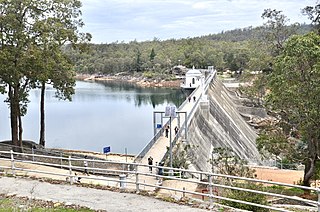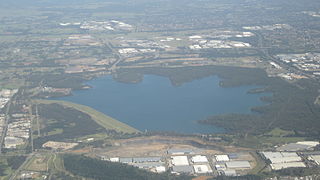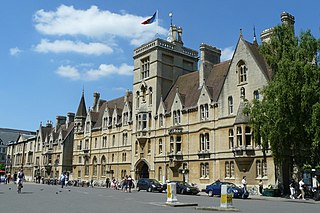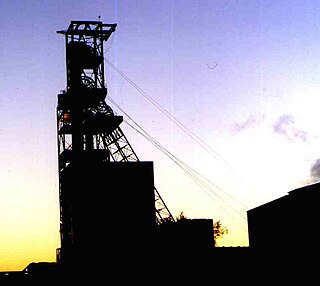Related Research Articles

A gold rush or gold fever is a discovery of gold—sometimes accompanied by other precious metals and rare-earth minerals—that brings an onrush of miners seeking their fortune. Major gold rushes took place in the 19th century in Australia, Greece, New Zealand, Brazil, Chile, South Africa, California, the United States, and Canada while smaller gold rushes took place elsewhere.

The Kionga Triangle was a small region of German East Africa situated at the mouth of the Ruvuma River. The Ruvuma served as the border between the German colony and Portuguese Mozambique, and the Kionga Triangle was the only section of German East Africa south of the river. Its principal settlement was Kionga which had a population of 4,000 in 1910. It became a German possession in 1894 but came under Portuguese control in April 1916 during World War I. The post-war Treaty of Versailles reaffirmed that the river was the border between Tanganyika, then under British control, and Portuguese Mozambique. The triangle was the only territory that the treaty awarded to Portugal.
The Ashanti Goldfields Corporation is a gold mining company based in Ghana that was founded by Joseph Ellis and Joseph Biney both from Cape Coast. The Ashanti Mine, located at Obuasi, 56 km south of Kumasi, has been producing since 1897. During the turn of the century 1900, the Ashanti Goldfields Corporation was among the most important gold mining companies listed at the London Stock Exchange. The mine is sited on one of the world's major gold deposits and is one of the ten largest in the world.

Southern Cross is a town in Western Australia, 371 kilometres east of state capital Perth on the Great Eastern Highway. It was founded by gold prospectors in 1888, and gazetted in 1890. It is the major town and administrative centre of the Shire of Yilgarn. At the 2016 census, Southern Cross had a population of 680.

Welkom is the second-largest city in the Free State province of South Africa, located about 140 kilometres (90 mi) northeast of Bloemfontein which is the provincial capital. Welkom is also known as Circle City, City Within A Garden, Mvela and Matjhabeng. The city's Sesotho name, Matjhabeng means 'where nations meet', derived from the migrant labour system, where people of various countries such as Lesotho, Malawi and Mozambique etc. met to work in the mines of the gold fields.

Obuasi is a gold mining community and town which is the capital of the Obuasi Municipal District in the Ashanti Region of Ghana. It lies in the southern part of the Obuasi Municipal, 39 miles south-west of Ashanti capital city Kumasi. Obuasi has a population of 175,043 people. Obuasi mining community has a mixture of the Ashanti people culture and the semi-island exclave Ashantiland.

The Beechcraft Model 18 is a 6- to 11-seat, twin-engined, low-wing, tailwheel light aircraft manufactured by the Beech Aircraft Corporation of Wichita, Kansas. Continuously produced from 1937 to November 1969, over 9,000 were built, making it one of the world's most widely used light aircraft. Sold worldwide as a civilian executive, utility, cargo aircraft, and passenger airliner on tailwheels, nosewheels, skis, or floats, it was also used as a military aircraft.
The Baptist Theological College of Southern Africa (BTC) is a Baptist theological institute located in Randburg, South Africa. The college's current principal is Prof. 'Piff' G. C. Pereira who succeeded Prof. Martin Pohlmann who had served as the Principal for 14 years until 2017.

Mundaring Weir is a concrete gravity dam located 39 kilometres (24 mi) from Perth, Western Australia in the Darling Scarp. The dam and reservoir form the boundary between the suburbs of Reservoir and Sawyers Valley. The dam impounds the Helena River.

The Prospect Reservoir is a heritage-listed 50,200-megalitre potable water supply and storage reservoir created by the Prospect Dam, across the Prospect Creek located in the Western Sydney suburb of Prospect, in New South Wales, Australia. The eastern bounds of the reservoir are a recreational area and the western periphery are within the bounds of Western Sydney Parklands. It was added to the New South Wales State Heritage Register on 18 November 1999.

Mining in South Africa was once the main driving force behind the history and development of Africa's most advanced and richest economy. Large-scale and profitable mining started with the discovery of a diamond on the banks of the Orange River in 1867 by Erasmus Jacobs and the subsequent discovery of the Kimberley pipes a few years later. Gold rushes to Pilgrim's Rest and Barberton were precursors to the biggest discovery of all, the Main Reef/Main Reef Leader on Gerhardus Oosthuizen's farm Langlaagte, Portion C, in 1886, the Witwatersrand Gold Rush and the subsequent rapid development of the gold field there, the biggest of them all.

The Ngwenya Mine is located on Bomvu Ridge, northwest of Mbabane and near the northwestern border of Eswatini (Swaziland). This mine is considered to be the world's oldest. The haematite ore deposit was used in the Middle Stone Age to extract red ochre, while in later times the deposit was mined for iron smelting and iron ore export.
Evander is a town in Mpumalanga, South Africa. It is approximately 8 km north west of Secunda.
Union Corporation Limited was a South African mining house. It was founded as the A Goerz & Co Ltd in the late 1890's as a gold mining company. After World War One, it was renamed the Union Corporation. In 1980 it was merged into the General Mining and Finance Corporation later called Gencor.

Thomas Price Stratten was a South African engineer. He went to Oxford on a Rhodes Scholarship, followed by two years at American General Electric. He returned to South Africa in 1929 to the position of assistant electrical engineer at De Beers Consolidated Mines. He took senior positions at Iscor, the Union Corporation and Escom. After a time spent in the Directorate of War Supplies, he went on to successfully expand SAPPI's operations and was president of the South African Institute of Electrical Engineers during the 1940s.

Rand Water is a South African water utility that supplies potable water to the Gauteng province and other areas of the country and is the largest water utility in Africa. The water is drawn from numerous sources and is purified and supplied to industry, mining and local municipalities and is also involved in sanitation of waste water.

James Venture Mulligan's Grave is a heritage-listed grave at Bakers Road, Mount Molloy, Shire of Mareeba, Queensland, Australia. It was built in 1907. It is also known as Mount Molloy Cemetery. It was added to the Queensland Heritage Register on 21 October 1992.

The Free State Gold Rush was a gold rush in Free State, South Africa. It began after the end of World War II, even though gold had been discovered in the area around the year 1934. It drove major development in the region until the mid–to–late 1980s as part of the mineral revolution in South Africa.
Gencor Ltd was a South African based mining company. It was formed in 1980 after the merger of the General Mining and Finance Corporation and the Union Corporation. Parts of the company are now owned by Gold Fields and BHP.

The Guildford West pipehead and water supply canal is a heritage-listed sewerage infrastructure and water supply canal located at Frank Street, Guildford in the Cumberland Council local government area of New South Wales, Australia. It is also known as Headworks; Industrial Archaeological Site. The property is owned by Sydney Water, an agency of the Government of New South Wales. It was added to the New South Wales State Heritage Register on 15 November 2002.
References
- 1 2 "South African Heritage Resource Agency (SAHRA) database". Archived from the original on 31 December 2008. Retrieved 3 January 2009.
- ↑ History of Gencor Ltd., A Major Claim in the 1980s
26°30′31″S29°07′33″E / 26.50861°S 29.12583°E